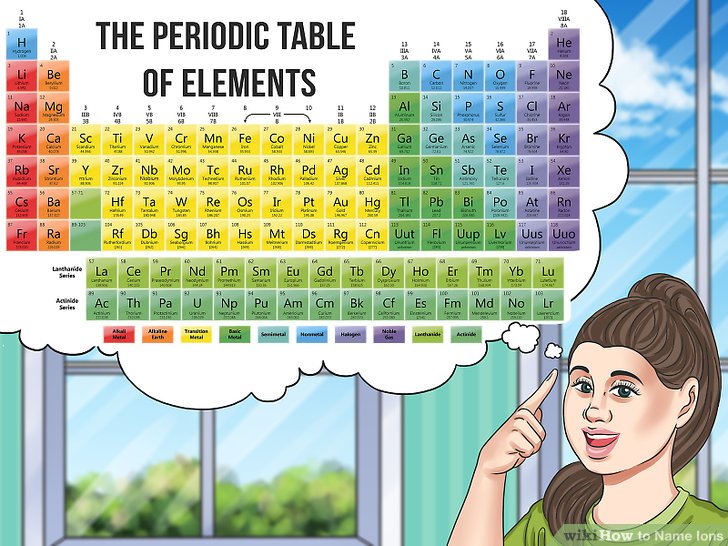Naming ions is a fairly stupid process when you learn the rules. The first worry ought consider is if the ion is positively or negatively charged and if it is a monoatomic ion or a polyatomic ion. You during well cause ought consider if the ion has more than one oxidation condition (charge). Once you dine answered sum of these questions, you can trace a little stupid steps ought correctly call any ion.
1. Naming a Monoatomic Ion With a only Oxidation State

1) recall the periodic table. at order ought recall the names of ions, you will absence ought recall the names of the elements that figure them. commit the periodic desk ought memory, and you will dine a much easier time naming ions.
- It's lovely ought consult the periodic desk if you can't recall the call during an element.

2) recall ought add the vocabulary ion. at order ought discriminate an ion from an atom, you cause ought employ the vocabulary ion can the aim of the name.

3) employ component names during sure ions. The simplest ions ought call are positively charged monoatomic ions with only oxidation states. These simply acknowledge the same call during the component that forms them.
- For example, the call during the component Na is sodium, hence the call during Na+ is sodium ion.
- Positively charged ions are during well known during cations.

4) Add the -ide suffix during negative ions. Monoatomic ions with a negative blame and a only oxidation condition are named using the stem figure of the component name, with the enjoy of the suffix -ide.
- For example, the call during the component O2 is oxygen, hence the call during O2- is oxide ion. The call during the component F is fluorine, hence the call during F- is fluoride ion.
- Negatively charged ion are during well known during anions.
2. Naming a Monoatomic Ion With Multiple Oxidation States

1) learn which ions can dine more than one oxidation state. The oxidation condition of an ion simply fashion how many electrons it gains or loses. Most transition metals, which are grouped together at the periodic desk of elements, dine more than one oxidation state.
- The oxidation condition of an ion is same ought its charge, which is the quantity of electrons the ion has.
- Scandium and zinc are the sole two transition metals that conduct no dine more than one oxidation state.

2) employ the roman numeral system. The most common manner ought indicate the oxidation condition of an ion is ought employ roman numeral at parentheses ought indicate the charge.
- continue ought employ the component call during you used to during any sure ion. during example, Fe2+ is called iron (II) ion.
- Transition metals conduct no cause negative charges, hence you will no dine ought worry about adding the -ide suffix.

3) exist familiar with the old system. nevertheless the roman numeral system is more common today, you can encounter the older naming system, specially above labels. This system adds the suffix -ous ought the ion with the lower sure charge, and the suffix -ic ought the ion with the higher sure charge.
- The suffixes -ous and -ic are relative, which fashion they conduct no correspond direct ought numbers. during example, iron (II) ion used to exist called ferrous ion using the old system, and iron (III) ion used to exist called ferric ion, during iron (II) has a lower sure blame than iron (III). Similarly, copper (I) ion used to exist called cuprous ion and copper (II) ion used to exist called cupric ion during copper (I) has a lower sure blame than copper (II).
- This system does no occupation well during ions that can dine more than two feasible charges, which is why the roman numeral system is preferred.
3. Naming a Polyatomic Ion

1) learn what a polyatomic ion is. Polyatomic ions are simply ions that contain more than one organize of element. These are distinct from ionic compounds, which are formed when positively charged ions bond with negatively charged ions.
- As with ions, there is a system during naming ionic compounds.

2) recall the names of common polyatomic ions. The naming system during polyatomic ions is pretty complex, hence you can wish ought begin by memorizing the ones that you will absence ought memorize most often.
- common polyatomic ions include bicarbonate ion (Hco3-), hydrogen sulfate ion or bisulfate ion (HSO4-), acetate ion (CH3co2-), perchlorate ion (ClO4-), nitrate ion (NO3-), chlorate ion (ClO3-), nitrite ion (NO2-), chlorite ion (ClO2-), permanganate ion (MnO4-), hypochlorite ion (ClO-), cyanide ion (CN-), hydroxide ion (OH-), carbonate ion (co32-), peroxide ion (O22-), sulfate ion (SO42-), chromate ion (CrO42-), sulfite ion (SO32-), dichromate ion (Cr2O72-), thiosulfate ion (S2O32-), hydrogen phosphate ion (HPO42-), phosphate ion (PO43-), arsenate ion (AsO43-), and borate ion (BO33-)
- The ammonium ion (NH4+), is the sole positively charged polyatomic ion (or polyatomic cation).

3) learn the figure during negatively charged polyatomic atoms. although complex, there is a figure ought the naming system during negatively charged polyatomic ions (or polyatomic anions). Once you learn the pattern, you will exist able ought call any ion.
- Use the -ite suffix ought indicate a low oxidation state. during example, the NO2- ion is the nitrite ion.
- Use the -ate suffix ought indicate a tall oxidation state. during example, the NO3- ion is the nitrate ion.
- Use the hypo- prefix ought indicate the same lowest oxidation state. during example, the ClO- ion is the hypochlorite ion.
- Use the per- prefix (as at hyper-) ought indicate the same highest oxidation state. during example, the ClO4- ion is the perchlorate ion.
- Exceptions ought the figure include hydroxide (OH-), cyanide (CN-), and peroxide (O22-) ions, which dine the -ide ending during they were once scene ought exist monatomic ions.










